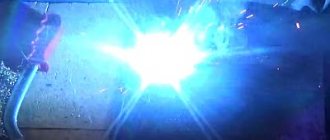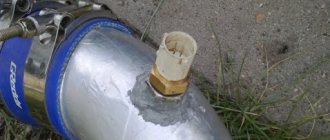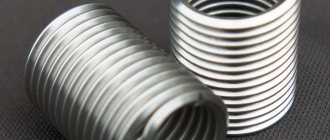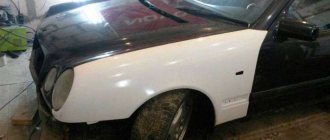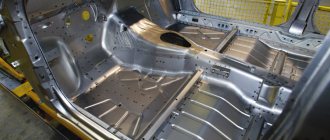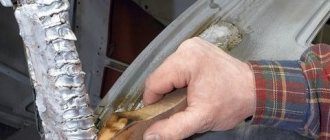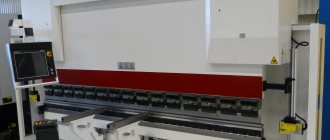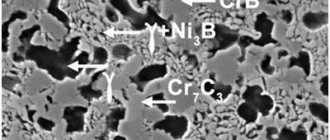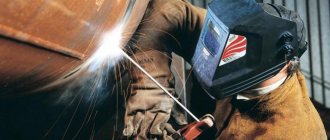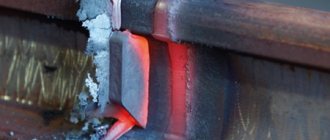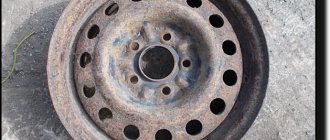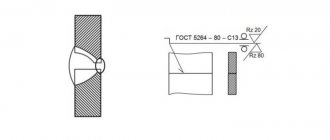Wear of mechanical elements occurs unevenly. In this case, due to damage that is small compared to the size of the part, its performance is lost. Accordingly, the functioning of the unit or even the entire mechanism deteriorates or stops. Among the methods of metal restoration, restoration of parts by welding and surfacing is in first place in terms of prevalence. There are two main reasons:
- Restoring the original properties of the element.
- Relatively cheap.
In the article we will focus on the practical application of restoration techniques in relation to body welding work on cars and trucks.
What does the repair involve?
The processes of welding and surfacing are fundamentally different . In the first case, the melt is used to join the parts. In the second, it acts as a working layer, which is applied to the surface of the part in order to restore its original dimensions.
There are situations when these functions coincide. An example is the restoration of the underbody of a car damaged by corrosion. At the same time, severely damaged areas are replaced with sheets of metal, cracks and holes are restored by surfacing.
In other cases, the wear on the axle or frame of the body part is completely restored by surfacing . At the same time, welding can be used to repair (for example) a crack on the same element.
Another example: welding a truck frame. Here, the elements of the supporting frame where cracks have arisen are welded, and the excavations in the eyes and grooves for fastening units, rods, axles, etc. are welded.
As for iron wear, choosing repair by surfacing is not always advisable . If an automobile plant produces the necessary components, repairs may come down to cutting out the worn part and then welding a new one.
As a rule, welding of a car body is used more often than surfacing on its parts. The reason is the nature of wear caused by the similarity of causes of damage during operation.
It doesn’t matter what brand it is: a VAZ 2109, a Hyundai Porter truck, a Lexus or an old Niva - the majority of body damage is due to corrosion and deformation of sheet metal during accidents.
The essence of restoration by welding and surfacing
Both methods are based on thermal effects, only the settings of the equipment used differ. Surfacing is the application of a layer of an alloy of base and filler metal to the surface of parts. By surfacing, not only geometric dimensions are restored, but also coatings are applied to increase heat resistance, strength, wear resistance, etc. The procedure can be performed on surfaces of any shape - from flat to conical and spherical.
Welding is the process of creating a connection between metal elements using melting or pressure. This method is used to repair cracks, chips, and holes from holes, and to fasten broken elements. Such damage to frames, pallets, bodies, and both axles is constantly encountered when repairing cars. Welding is also used in conjunction with other restoration procedures.
For high-quality restoration of parts by welding and surfacing it is necessary:
Equipment used
With all the variety of work methods and tooling, the classification of welding during car repairs comes down to only two types:
- Electric, mainly arc using shielding gases or fluxes.
- Gas, using acetylene or propane.
Electric is divided into manual, semi-automatic in an inert gas environment, submerged, etc.
There are other methods, such as laser, friction, and diffusion welding. However, they are practically not used for car repairs.
In some cases, a type of welding is used, such as soldering . It is used to repair damage to pipes made of non-ferrous metals, radiator blocks, and parts of refrigerator equipment made of thin copper.
Which welding is best for welding a car body depends on the nature of the damage, as well as the characteristics of the place or part that needs to be restored.
Today, the majority of work is carried out using electricity. Gas welding, which was once almost the only method of repair, is today used to connect parts made of thin metal.
In addition, oxy-acetylene welding is still popular where various rods that create dynamic loads are attached to the body .
Electrical appliances for small repairs include car welding using an inverter or a conventional manual welding machine. For delicate work that requires high quality, as well as surfacing, semi-automatic machines with carbon dioxide or inert gas are used.
With the spread of aluminum and titanium alloys, the arsenal of repair mechanics was replenished with arc welding devices using a non-consumable electrode in an inert gas environment. With feeding of the melting filler rod by hand or automatically.
Part preparation requirements
The quality of restoration largely depends on how correctly we prepare the part . This applies to welding, and especially surfacing.
The metal is thoroughly cleaned of rust using an angle grinder (angle grinder), better known as an “grinder.” Or with a hand brush. If necessary, chamfer or level.
In critical cases, during surfacing and soldering, the surface is degreased.
Sandblasting or waterjet treatment gives a good effect..
The cracks are cut with angle grinder grinding discs to the full depth to obtain V-shaped grooves in their place. Thick metal is processed on both sides. At their ends, to eliminate stress and prevent further development, through holes with a diameter of 4-6 mm are drilled.
Before fusing the holes, their edges are countersunk on one or both sides; if there is a thread, it is drilled out.
Considering that welding a car with an electrode or gas flame creates a high temperature, care should be taken to ensure the safety of adjacent finishing elements, electrical components. equipment, plastic parts.
To do this, remove the element being repaired or parts that may be damaged. If this is impossible for some reason, measures are taken to protect them (close them, cover them with wet rags).
Electrodes used
The selection of electrodes or welding wire is carried out based on three parameters:
- Type of metal.
- The required thickness of the part or surfacing layer.
- The level of responsibility of the part being restored.
When performing body repairs semi-automatically with carbon dioxide, flux-cored welding wire, copper-plated or plain, is used.
Surfacing of a layer with high hardness characteristics is carried out using electrodes of the T-620 type, with a thick coating including graphite, boron carbide, etc.
The required diameter of the electrode is selected based on the thickness of the metal being welded, according to special tables.
Aluminum parts are connected by gas (oxyacetylene) or arc welding. In the latter case, OZA-2 type electrodes are used. When using technology with a non-consumable tungsten electrode, a rod of the corresponding aluminum alloy is used as an additive.
When surfacing worn engine parts to obtain alloyed coatings, wire of the Np-65 type with a high carbon content is used. Work is carried out under submerged arc, in an environment of inert gases.
§41. Surfacing
Surfacing
is the application of a layer of metal or alloy to the surface of a product by fusion welding.
Restorative surfacing is used to restore the original dimensions of worn or damaged parts. In this case, the deposited metal is similar in composition and mechanical properties to the base metal.
Surfacing of functional coatings serves to obtain a layer with the required properties on the surface of products. The base metal provides the necessary structural strength. The layer of deposited metal imparts special specified properties: wear resistance, heat resistance, heat resistance, corrosion resistance, etc.
Surfacing has become widespread in the restoration of supporting surfaces of rotating parts, various sliders and their guides, splined surfaces, worn gear teeth, etc. When using high-quality surfacing material, the service life of restored parts is significantly increased. Using cast carbide alloys, a hard, wear-resistant and heat-treated weld surface is obtained.
Surfacing methods: - Manual arc surfacing with coated electrodes - Submerged arc surfacing with wires and strips - Gas-shielding arc surfacing with tungsten (non-consumable) and wire metal (consumable) electrodes - Arc surfacing with self-shielding flux-cored wires - Electroslag surfacing - Plasma surfacing - Laser surfacing - Electron beam surfacing - Induction surfacing - Gas flame surfacing
Surfacing is carried out manually or automatically with an electric arc. As the electrode (wire) melts, the metal of the part also melts.
When manual surfacing, electrodes with thick coating are used. Automatic surfacing is carried out under a layer of loose flux, which protects the combustion zone, arcs and molten metal from oxygen and nitrogen in the air and ensures arc stability.
For surfacing and welding, electrode wire with a diameter of 1.5-2.5 mm of the following grades is used: Sv08, Sv08A, Sv08G, Sv08GA, Sv1072, Sv15G, etc. The most widely used fluxes for surfacing are high-manganese and high-silicon fluxes of the AN-348A grades, AN-348AM, OSC-45.
Flux-cored wire and strip electrodes are also used for surfacing. Flux-cored wire is made from a thin steel strip, which, when rolled into a tube, is filled with a mixture of iron and ferroalloy powders. By using different compositions of powders, it is possible to obtain weld metal with different mechanical properties.
Surfacing of cast hard alloys is carried out using an acetylene-oxygen carburizing flame with an excess of acetylene. Before surfacing, the surface of the part must be thoroughly cleaned. If the part has a lot of wear, exceeding the thickness of the welding layer, then it is recommended to pre-weld it. For welding, the appropriate filler material is used. After welding, the surface is subjected to mechanical processing.
A type of arc surfacing is vibro-arc surfacing. Surfacing with this method is carried out with a vibrating electrode using an automatic head using coolant. The process occurs with low heating of the part being restored, no deformation, and an insignificant size of the heat-affected zone, as a result of which the chemical composition and physical and mechanical properties of the part remain almost unchanged.
In the auto repair industry, the surfacing head UANZh-6 designed by NIIAT is most widely used.
Source
Methods for welded repair of car and truck bodies
A variety of technologies are used to weld the body of both passenger cars and trucks. Fundamentally, they all boil down to an electric arc or a hot gas stream, but at the same time they often have significant technological differences.
Manual arc
Both AC and DC devices are used for work . The first include welding transformers of various types. The latter are represented by welding machines and generators.
The transformer produces an unstable arc and requires significant current across the diameter of the electrode (this characteristic is called current density). At the same time, the temperature of the arc increases, which is fraught with burnout and overheating.
This danger was relevant for old welding transformers, and even now the question: is it possible to weld a car with electric welding does not always give a positive answer. At a minimum, if we are talking about homemade devices or ordinary welding transformers.
The situation has changed with the advent of inverter devices, but this type of connection is used to a limited extent for connecting elements made of thin metal.
As a rule, this method is used to repair massive parts, such as frames or assemblies made of thick metal, for example, mufflers.
A. Tarkhomov, a welder with 20 years of experience: “With a modern inverter, the body can be welded in most cases. Of course, with a professional level device. Everything depends on the welder. A non-specialist should absolutely not do such things.”
Automatic submerged surfacing
It is used quite widely for repairing industrial equipment, especially unique ones. For automotive repairs, the distribution is usually small, for restoration by surfacing of rotating parts (for example, a camshaft) .
The meaning of the method is that the welding arc does not burn openly, but under a layer of special powder - flux. It protects the metal from oxidation and combination with air nitrogen. The quality of the weld or surfacing layer is not inferior to the original metal, and when using special electrodes it can exceed it in hardness and wear resistance.
Vibro-arc method
Like submerged arc surfacing, it is used exclusively in factory conditions, since it requires bulky installations that ensure accurate positioning of the part.
The meaning lies in the oscillatory movements of the melting electrode with a frequency of 100-120 Hz, at a voltage of 12-18 Volts. In this case, surfacing is performed with tiny particles of metal with simultaneous cooling.
In gas protective environments
A method that gives the highest quality results in service stations and repair shops.
Welding or surfacing is carried out in an inert gas environment using a non-consumable electrode (TIG), or with a fusible electrode surrounded by an inert or active gas (MIG/MAG welding, respectively).
Allows you to obtain a connection that is not inferior to that made in the factory . But most importantly, with the help of this method, for the first time, current repairs of parts made of titanium and aluminum alloys and high-strength alloy steels became available to motorists.
Semi-automatic methods
One of the most popular methods used today by small workshops and private craftsmen .
The process is carried out in air or under carbon dioxide. Welding wire of the required composition is used as a consumable electrode. It is served by unwinding from the reel as needed.
Moreover, even household-level devices are capable of automatically adjusting the wire feed speed depending on the arc strength.
Alternative Pressure Recovery Technology
To restore parts under pressure, surfacing or welding is not required. The part is only preheated to plasticity.
The meaning of the method is to change the geometric dimensions of parts during their deformation. There are three main methods:
- draft;
- compression;
- casing.
In the first case, when cylindrical parts such as bushings are compressed, the internal diameter decreases with decreasing height. By crimping, I reduce the lateral deformations of the part, and when casing, on the contrary, they increase it (see picture photo 
In some cases, such operations are supplemented or preceded by surfacing.
Welding and surfacing under a layer of flux
Reduction by this method is carried out with an electric arc, which burns under molten flux. Thus, an elastic shell is created that protects the molten metal from contact with air. Fluxes also maintain arc stability, deoxidize, alloy, and refine the deposited metal.
Two types of fluxes are used for welding and surfacing:
Submerged arc surfacing of metal is carried out using uncoated welding wire. The diameter (1 - 6 mm) is determined by the thickness of the layer being created, the shape of the rollers, and the dimensions of the parts. To increase productivity, restoration is carried out using strip electrodes up to 10 cm wide or simultaneously with two wires fed by different mechanisms.
Restoration is performed using direct current with reverse polarity. On round parts, the rollers are placed in increments of 2 - 6 wire diameters. To reduce deformation on a flat surface, surfacing is carried out through a bead or alternately in different areas.
